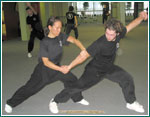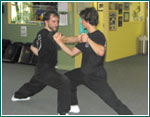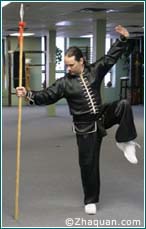The difference between Traditional and Modern Wushu
A-Usability; Traditional wushu focuses on fighting martial applications of movements (yong fa). Whereas contemporary Wushu focuses on aesthetics and performance.
B-Body mechanics; Traditional wushu focuses on generating power in proper joint and limbs alignment and the right kind of released energy (jing), as there are different types of jing for different purposes, one must be able to show those differences in their techniques. The movements are not only done fast and accurate, but also shows proper "jing". In contemporary Wushu, since the goal is for performance, the body mechanics generally disregard the use of proper Jing.
C-Curriculum; When you look at a school's curriculum, you can often find hints about the school being traditional or not. For example, Kung Fu styles such as Eagle Claw, Praying Mantis, Bagua, Tongbei etc... are COMPLETE SYSTEMS by themselves. If the school claims to teach "Shaolin Kung fu" (which is a very general term) and they teach one form of each style, the school doesn't have a system, just a collection of forms from different systems.
While it's common, especially in northern styles, to include forms from other systems as complementary material, they still have a CORE SYSTEM in which the techniques and forms share fighting principles and strategy. Therefore if you see a school that contains a great variety of unrelated styles, the question to ask is: What are the core principles of the system? And is it omnipresent in the style's forms and techniques.
D-Respect of the traditional "protocol"; A traditional school means that it follows a tradition that was passed from teacher to student for generations. The teacher is addressed as "Shifu" (not by his first name), the teacher's teacher is addressed as "Shigong" etc...(in contemporary Wushu, the teacher is called a "coach" as in most sports). The students bow at the door, usually towards the grandmaster's picture up on the wall, to pay respects to the ancestors as well as the training hall where the student is going to grow as a person as well as a martial artist.
About forms training in traditional Chinese martial arts
There is a large misconception about traditional Chinese Kung fu. Some people wrongly think, that traditional means that we only practice forms. The forms are an important tool to traditional Chinese kung fu. But not the only tool.
Those misconception, in my opinion come from two sources:
1- Bad schools that call themselves traditional but don't even know the applications of their moves (those schools give Kung fu a bad name).
2- Lazy martial artists that trained for a year in this and two years in that (in other words never long enough to understand the systems) and thus discard forms training as being useless.
What forms teach you: Proper footwork, body mechanics, power generation, strength and stamina, fluidity between movements, balance,
What forms DON't teach you: Timing, reflexes, conditioning,
What traditional training should include
Traditional Kung fu training should include every one of those methods of training.
A-Empty hand Forms: Teaches proper footwork, body mechanics, power generation, strength and stamina, fluidity between movements, and balance.
B-Two persons forms (or two-persons drills): Teaches timing and reflexes, shows an example of how to use the techniques in combat. It is understood that a real situation will probably never occur as in the form. That is why those 2-person forms should be broken down and trained as individual techniques in different scenarios.
C-Conditioning: Heavy bag work, wall bags, strengthening exercises, iron palm etc...
D-Weapons and two-person weapons sets: By learning how to use a weapon to defend yourself you develop the ability to turn any object into a weapon (long, short, single, double, flexible etc..) for example a broadsword techniques could easily be used with an umbrella or other object of the same length. You also develop additional strength in your hand techniques by practicing "Jing" with a weapon.
E-Chi gong and internal development: Traditional Kung fu doesn't rely solely on physical strength, otherwise there wouldn't be any Kung fu masters passed the age of 50. Internal development is unavoidable when you reach a certain age. By Chi gong I don't mean circus tricks, but really internal development through breathing exercises.
F-Free-fighting: Without free-fighting all of this training would be pointless
If one of those items is missing, the training should NOT be labeled traditional.
But this doesn't end there. Those methods must be trained PROPERLY. For example, training forms without proper body mechanics to generate power is a waste of time. Training two-persons forms without the proper "spirit", just mechanically won't do much good. In other words studying a traditional system doesn't suffice. You need the guidance of a Shifu who will make sure the training is done the right way.
Four steps to learning how to fight
Once you've learned the basic techniques of your system (mainly through solo forms practice), you're ready to start applying the techniques to actual combat. This is usually done in four steps.
First step: Two-persons forms is the first step to developing timing and reflex. It shows you the techniques in a limited context. You already know where and when the attack will take place, so you can focus on executing the technique correctly. It is understood that before engaging in 2-persons form, one must have learned the basic techniques first.
Second step: One on one drills. It allows you to isolate the techniques learnt in a form, and drill them with a partner. Try them in different situations (different angle, different side, against different types of attacks etc...) This allows you to really explore your technique and find out the way to use it that suits you best.
Third step: One-step sparring, which puts more emphasis on reflexes and timing, since you don't know what your opponent is going to do, but it's still limited to one encounter at a time.
Fourth step: Free fighting. Applying the moves you have learned in your forms in a free-fighting situation is what every traditional martial artist should be aiming for.








